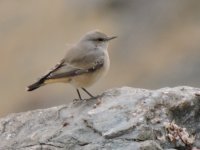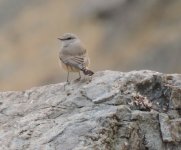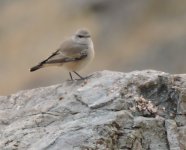-
Welcome to BirdForum, the internet's largest birding community with thousands of members from all over the world. The forums are dedicated to wild birds, birding, binoculars and equipment and all that goes with it.
Please register for an account to take part in the discussions in the forum, post your pictures in the gallery and more.
You are using an out of date browser. It may not display this or other websites correctly.
You should upgrade or use an alternative browser.
You should upgrade or use an alternative browser.
Persian or Kurdish Wheatear? Tehran,Iran (1 Viewer)
- Thread starter ehsan
- Start date
More options
Who Replied?Iraq Babbler
Well-known member
female xanthoprymna
Omar
Omar
jogresh
Bimble and patch
Nice photo! Given that it has rufous at the tail base, if it's a xanthoprymna it'd have to be an immature if i understand it correctly. Given that it has this feature, and a pale throat, fairly pale vent area, and rufous ear coverts, i would have plumped for chrysopygia. However i've only seen the latter and not Kurdish (yet!).
Cheers.
Cheers.
Last edited:
It's certainly a Persian Wheatear (Oenanthe chrysopygia)! The book "Advanced Bird ID Guide - The Western Palearctic" summarizes the situation as follows: adult female Kurdistan Wheatear (O. xanthoprymna) has <<diffuse dark throat-patch>>, while <<pale throat in some 1s resembling both sexes of Persian, but lack distinct blue-grey neck sides and breast>>; Kurdistan Wheatear also has: <<dark grey-brown upperparts and only slightly paler underparts (upperparts thus darker than in Persian)>>...
As this individual clearly shows a light grey throat, a neat blue-grey patch across its neck and head sides, and a light "cappuccino" uppurparts contrasting with paler and more buffy underparts, this should be a Persian Wheatear, surely a 1°winter, as demonstrated by the fresh state of its plumage! Females Kurdistan Wheatears I observed in Turkey always were darker brown, less neatly grey and with less contrasting plumage...
Hallo, Igor Festari
As this individual clearly shows a light grey throat, a neat blue-grey patch across its neck and head sides, and a light "cappuccino" uppurparts contrasting with paler and more buffy underparts, this should be a Persian Wheatear, surely a 1°winter, as demonstrated by the fresh state of its plumage! Females Kurdistan Wheatears I observed in Turkey always were darker brown, less neatly grey and with less contrasting plumage...
Hallo, Igor Festari
Iraq Babbler
Well-known member
the issue of this bird is fresh young as you may noticed it is still in the primary molt, g cov. have not molted yet , except the upper lcov. mantal fethers not replaced yet, so the black on throat expected to emerge later for both spp. the greyish smear is present in both persio-kurdish see
http://www.birdsofkuwait.com/blog/wp-content/2011/01/Kurdistan_Wheatear_MG_0151_.jpg
The capaccion color of the mantel is fake for this bird as it still fresh young and the new sholder feathers are the new one see the first pic of second set but still not safe to count on . The thing it has rich redish on under tcov and under parts. dark lore and lack of distctive supercil. for 1st winter bird.
Omar
http://www.birdsofkuwait.com/blog/wp-content/2011/01/Kurdistan_Wheatear_MG_0151_.jpg
The capaccion color of the mantel is fake for this bird as it still fresh young and the new sholder feathers are the new one see the first pic of second set but still not safe to count on . The thing it has rich redish on under tcov and under parts. dark lore and lack of distctive supercil. for 1st winter bird.
Omar
the issue of this bird is fresh young as you may noticed it is still in the primary molt, g cov. have not molted yet , except the upper lcov. mantal fethers not replaced yet, so the black on throat expected to emerge later for both spp. the greyish smear is present in both persio-kurdish see
http://www.birdsofkuwait.com/blog/wp-content/2011/01/Kurdistan_Wheatear_MG_0151_.jpg
The capaccion color of the mantel is fake for this bird as it still fresh young and the new sholder feathers are the new one see the first pic of second set but still not safe to count on . The thing it has rich redish on under tcov and under parts. dark lore and lack of distctive supercil. for 1st winter bird.
Omar
Pardon me Omar, but I again disagree with your assessment here, as well as with the photo that you use as an example of 1w Kurdish Wheatear.
- The OP bird is not moulting its primaries; they are all there, as far as we can tell from the photographs;
- In birds, all moult processes include the body feathers (including mantle). It therefore makes no sense to state that a bird would have moulted some wing coverts, but not the mantle feathers.
Anyway, the OP bird differs from 1w Kurdish Wheatear mainly in that its plumage is much paler, sandy-grey, and because its undertail coverts are clearly paler than the red tail. Other strong indications are the contrastingly grey lesser coverts, plain greater coverts, and grey nape. 1w Kurdish is a darker bird overall, with dark ear-coverts, rather dirty looking throat, and with almost reddish vent matching the colour of the tail. An example:
https://www.flickr.com/photos/13994274@N03/2062588727
The photo you linked to shows a Persian Wheatear. Note the whitish undertail coverts, grey nape, obviously grey lesser coverts, pale rufous ear-coverts and white throat. If you look at the Birds of Kuwait website rather than just Google Images, you will also find that the photo is captioned as Oenanthe chrysopygia (i.e. Persian): http://www.birdsofkuwait.com/blog/?p=3406
jogresh
Bimble and patch
the issue of this bird is fresh young as you may noticed it is still in the primary molt, g cov. have not molted yet , except the upper lcov. mantal fethers not replaced yet, so the black on throat expected to emerge later for both spp. the greyish smear is present in both persio-kurdish see
http://www.birdsofkuwait.com/blog/wp-content/2011/01/Kurdistan_Wheatear_MG_0151_.jpg
The capaccion color of the mantel is fake for this bird as it still fresh young and the new sholder feathers are the new one see the first pic of second set but still not safe to count on . The thing it has rich redish on under tcov and under parts. dark lore and lack of distctive supercil. for 1st winter bird.
Omar
Hmm i would say that the bird in the link may also be a Persian Wheatear, with grey on the sides of the neck, pale-ish vent, russet ear coverts and white throat..
Edit: cross posted with smiths.
Last edited:
Iraq Babbler
Well-known member
Pardon me Omar, but I again disagree with your assessment here, as well as with the photo that you use as an example of 1w Kurdish Wheatear.
- The OP bird is not moulting its primaries; they are all there, as far as we can tell from the photographs;
- In birds, all moult processes include the body feathers (including mantle). It therefore makes no sense to state that a bird would have moulted some wing coverts, but not the mantle feathers.
. If you look at the Birds of Kuwait website rather than just Google Images, you will also find that the photo is captioned as Oenanthe chrysopygia (i.e. Persian): http://www.birdsofkuwait.com/blog/?p=3406
Yes, as i said this bird is a fresh young bird and in its primary molt , it primaries and gcov not molted yet as far as i can see,thus i can depend on the plumge coloration.
see the url i posted before it adresses as kurdistan wheatear i attached it again , and perhaps you know both spp were considered one as you will find two names.
http://www.birdsofkuwait.com/blog/wp-content/2011/01/Kurdistan_Wheatear_MG_0151_.jpg
Similar bird here
http://www.birdforum.net/showthread.php?t=185980
My typical chrysopyga would be according to the reasons i mentioned above espacially the paler under tail covs and distective pale superc.
Omar
Tib78
Well-known member
Omar, I don't quite get why you are insisting on an (allegedly) ongoing primay moult. The primaries look fully grown to me and very fresh, so unless there is something I don't know about the moult of Kurdish/Persian wheatear, I would not not expect the primaries to be moulted any time soon.
And the OP bird looks like a Persian to me too, for the reasons outlined by others.
And the OP bird looks like a Persian to me too, for the reasons outlined by others.
I second the idea that the bird presented in the original photos is a classic 1°winter with neatly fresh plumage, with no sign of wing moult, especially on primaries...
Also, I agree with others about the bird in the last sent photo being a Persian Wheatear, not a Kurdish!
I suspect that Kurdish is much more a short migrant than Persian, with few seen in winter far south from their breeding grounds and usually in westernmost middle-eastern countries (such as Cyprus, Syria, Israel, Egypt, ecc. where generally considered very rare or vagrant). At the contrary, Persian breeds east of Caspain Sea and overwinters more widely in south-western Asia, from Red Sea Coast, Iraq and coastal Iran to south Arabian peninsula and north-west India, so it should be considered more prone to appear far from its normal breeding range!
Hello
Also, I agree with others about the bird in the last sent photo being a Persian Wheatear, not a Kurdish!
I suspect that Kurdish is much more a short migrant than Persian, with few seen in winter far south from their breeding grounds and usually in westernmost middle-eastern countries (such as Cyprus, Syria, Israel, Egypt, ecc. where generally considered very rare or vagrant). At the contrary, Persian breeds east of Caspain Sea and overwinters more widely in south-western Asia, from Red Sea Coast, Iraq and coastal Iran to south Arabian peninsula and north-west India, so it should be considered more prone to appear far from its normal breeding range!
Hello
You're not making much sense here. Primaries are either in moult or moulting, not both. It is one or the other.in its primary molt , it primaries and gcov not molted yet.
As we have already said here, and as that website itself states, this is a Persian Wheatear.see the url i posted before it adresses as kurdistan wheatear i attached it again , and perhaps you know both spp were considered one as you will find two names.
http://www.birdsofkuwait.com/blog/wp...r_MG_0151_.jpg
Yes, that is a Kurdish Wheatear. I would not really consider it similar: it has white tail base, reddish vent, and dark ear-coverts, unlike the OP and Kuwait birds.Similar bird here: http://www.birdforum.net/showthread.php?t=185980
Iraq Babbler
Well-known member
Well, I should clarfy this :
Primary molt: is the first molt of juv- 1st winter which I meant in my post not " Primaries' molt" which I stated and was no primaries molted, but the primary molt or juv. molt is on going as some in the wing Lcov. and mantle.
In this particular bird, which is a fresh juv. nothing can be considered as a solid evidence to rule out Kurdish except the distribution range.
1. coloration is too similar Juv. Kurdish as well.
2. Greyish smear is also found in both especially for the 1st w.
3. IMO is too deep color in belly, under tail coverts, and tail feather basis.
4. the lacking of broad super. in 1st winter bird or at least a hint of it in front of the eye.
Omar
Primary molt: is the first molt of juv- 1st winter which I meant in my post not " Primaries' molt" which I stated and was no primaries molted, but the primary molt or juv. molt is on going as some in the wing Lcov. and mantle.
In this particular bird, which is a fresh juv. nothing can be considered as a solid evidence to rule out Kurdish except the distribution range.
1. coloration is too similar Juv. Kurdish as well.
2. Greyish smear is also found in both especially for the 1st w.
3. IMO is too deep color in belly, under tail coverts, and tail feather basis.
4. the lacking of broad super. in 1st winter bird or at least a hint of it in front of the eye.
Omar
Tib78
Well-known member
Well, I should clarfy this :
Primary molt: is the first molt of juv- 1st winter which I meant in my post not " Primaries' molt" which I stated and was no primaries molted, but the primary molt or juv. molt is on going as some in the wing Lcov. and mantle.
Ok I now see what you meant by "primary moult", next time it will be perhaps better to refer to it as "post-juvenile" moult.
Yet, I have to disagree once more: I can't see any ongoing moult on the mantle and lesser coverts! And the bird still looks a Persian to me.
Users who are viewing this thread
Total: 2 (members: 0, guests: 2)







